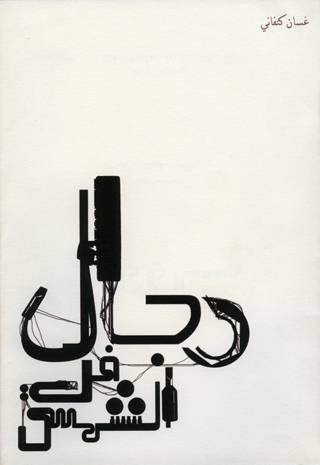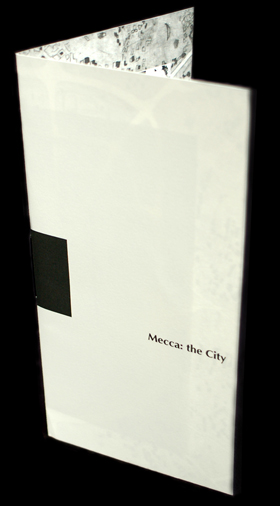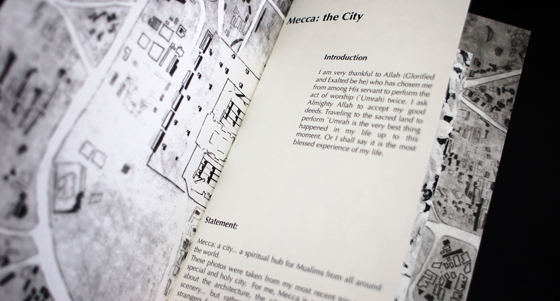Jonathon Russell
My experience in the United Arab Emirates started with a trip to visit my in-laws in Dubai for spring break in 2003. It was a fun trip with my wife and our 7-month old daughter Emma and included visits to 3 of the 7 emirates, Dubai, Abu Dhabi and Sharja. One trip consisted mainly of sight seeing and shopping with short tours of both the Dubai and Abu Dhabi campus of Zayed University1 where my father-in-law is an administrator. I was in my last semester of undergraduate study and was waiting to hear back from the schools where I had applied for graduate study, so I knew that I wanted to be a design educator, and felt that the UAE and Zayed University might be a good place to start my career.
 Ayla Al Dhaheri
Ayla Al Dhaheri
Book cover. An Arabic book about a family that is trying to escape from Iraq in the back of an empty water truck. The type was constructed from spare parts.
What I learned in Abu Dhabi
In 2005, I was completing my graduate studies in western Kansas. I had sent a digital portfolio of my work to the department chair at Zayed University in Abu Dhabi and was encouraged to apply for one of the three open graphic design positions. Interviewing for a position at ZU consists of a lot of email and a single three-way video-conference interview between the interviewee and the members of the search committee in Abu Dhabi and Dubai. The interview is taxing, stressful and confusing to say the least. I won the job and 5 months later was on my way, with my family, to the Middle East.
My teaching position at ZU was my first experience after graduating with my MFA. My only teaching experience had been as a graduate teaching assistant in two 300 level graphic design courses. I had never written a syllabus, directed a full class critique or graded an assignment on my own. I had spent countless hours in the lab working with students one-on-one for various projects and felt I had a good grasp on how to talk to students about design. This individual critique time is still one of my strengths as an educator today. Needless to say it was with great trepidation I walked into my studio for the first time as the instructor of record. And to compound the issue I was in a foreign country and culture with which my complete experience had been shopping trips 2 and-a-half years earlier. I will admit that I had some preconceived notions on how things would work out in my classroom. I would be the star, and my students would be my disciples. We would take over the design world with great work and the sound application of concept and theory. It took only one class to realize that this would not be the case. Instead, I learned a number of valuable lessons:
As much as Americans are told that our culture permeates even the most remote areas of the globe, it is not true.
Some areas of American culture are everywhere, things like McDonalds, Coke and Nike. There was a mall a block from our flat that had all of the following restaurants in the food court: McDonald’s, Pizza Hut, Hardee’s, KFC, Burger King and Fudruckers. There was a Papa John’s, Chili’s and Krispy Kreme in a mall just across town. It seemed like there was a Baskin Robin’s on every corner and I saw Hummer’s(GM), Charger’s (Dodge), Expedition’s (Ford) and even the occasional Cadillac driving around the city. Nike and Reebok were in all of the shoe stores, and Levi’s weren’t too hard to find either. The consumer and entertainment aspect of our country were everywhere you looked, but the cultural side of America was absent. And that is what made teaching in the first few months of my stay hard. I had never interacted with a group of people who had such a different set of cultural cues to pull from. I admit I had a lot of fun explaining American phrases to my students, but I was finding it hard to connect with them. I can’t remember exactly when it happened but at some point I decided to stop trying to turn the students into your American designers, and start helping them to be young Emirati designers. And when I discovered this, I was glad that these students had not been taken over completely by US consumer culture. This is not to say the transition was not hard for the students too. They had been bombarded with the idea that the west held all of the answers, that the key to success as a designer was to be found in the solutions that originated in the West, and their work should reflect this belief or it would not be “good”. I thought that is why I was there, to teach them to design like me, like an American or a European, but it wasn’t working so I let them be who they were, and the work got better. And more interesting. And more like what I thought Emirati design might become as they continue to find their own voices and blend the modern western world they are living in with the roots of their Islamic and Bedouin heritage.

 Amna Al Suwaidi
Amna Al Suwaidi
Capstone project. Identity for a proposed mass transit system in Abu Dhabi. In Bedouin societies the Mjree is the man who organizes and leads the caravan between settlements. The pattern is based on the streets of Abu Dhabi and echoes traditional Emirati and Islamic patterns.
The stereotypes of Muslim women, or Arabs in general, are not true.
The view of Muslim women widely held in the west is that they are oppressed, sad and lonely people. That the men in their lives lord over them and don’t allow any free expression or free thought. That they are not allowed to drive, must wear the Hijab at all times, and are never allowed to voice their own opinions. For the most part these stereotypes are not true of the Muslim women I taught and associated with. There are those who come from families that are stricter than others, but the same can be said for a lot of families in the middle of America. My students and colleagues were funny, smart, creative, independent and spoke their minds. They wore the Hijab proudly because they wanted to. And those that didn’t like the Hijab didn’t wear it. Not all of my students and their families were wealthy from oil. Some were still farmers and were supported by financial aid, just like in the US. In actuality, I felt a rather strong connection with a majority of the Emirati’s I met because their values and family connections were familiar to me–it felt a lot like the mid-west.
College students are the pretty much the same everywhere you go.
Not a lot of explanation needed here. These were 18-22 year old women. They surfed the Internet, sent text messages to their friends, had accounts on Facebook and MySpace, listened to music and laughed with their friends. Some were dedicated students, others were not. In fact, the only difference I have noticed between ZU and CMU, where I now teach, is that now I have men in my classes.
Too much of the design in the UAE and the Middle East in general is produced by western firms.
There are two types of design in the UAE: the high and the low. There really isn’t any middle ground. The low tends to be designed by small practitioners from India, Egypt, Jordan or Lebanon and the high is produced by international firms like Satchi and Satchi, Leo Burnett and Publicis. There is a growing number of design firms entering the UAE market, but they have very few, if any, Emirati designers and the students at ZU are very aware of this. The overall effect of this outsourcing of design is a very euro-centric visual environment, and a loss of traditional Emirati visual culture. My first inclination was to teach my students the merits of western design and send them out to create western design. After a time I realized that the cultural wells I would draw from for conceptual inspiration were basically irrelevant to my current students. A retro 1950’s piece or a wood type treatment had no place there. It was not who they were and they had no emotional connection to these pop cultural or historical references. So I encouraged them to look at their own history, their own cultural wells, and start to tell me stories about who they are. I stopped talking so much and began to listen more. And the more I heard the more excited I became about the future of Emirati design. I am not opposed to the large advertising agencies and design firms opening offices in the Middle East, it is a smart business move because that is were the money is right now. But the smart firms are going to start hiring the recent graduates and letting them do more than production work. And the face of design in the UAE, and the Middle East, will begin to change for the better.
 Mahra Al Mansouri
Mahra Al Mansouri
Book. A personal reflection on a visit to the holy Muslim city of Mecca.
The Emirati culture is quite unique and is being lost in a sea of glitz and surface glamour.
Related to the above lesson, the students loved telling me the stories of the UAE. The seven emirates that make up the United Arab Emirates are based on seven different Bedouin tribes. They were mainly herders and pearl divers, with some doing a little bit of farming in interior oases, and most of the students in my classes were only one generation removed from this nomadic life. They had lots of interesting stories about spending time on the family farm, and the experiences of their parents and grandparents. They have a very rich visual history that has only in the recent past turned to the standard gulf region wardrobe of black and white. A lot of this is being lost and can only be seen in the walled and sanctioned “heritage villages” in town and the occasional splash of color at the Co-Op seen on an Emirati grandmother. It is all being washed away in the rush to emulate the west in consumer consumption. My goal (once I figured things out) was to encourage my students to mine this heritage for conceptual material that would speak to their fellow Emirati’s and the students answered the call with beautiful projects that, in my mind, were a fantastic blend of a modern global lifestyle: traditional Bedouin culture and good design principles.
I enjoyed my time teaching the women of Zayed University and learned many valuable lessons that not only made me a better design educator, but a better, and more aware, global citizen.
Note
1 Zayed University is a state funded 4-year university founded in 1998 by Sheikh Zayed Bin Sultan Al Nahayan to educate the women of the United Arab Emirates. All ZU students are female UAE nationals and the university currently has an enrollment of approximately 3200 students across two campuses in Abu Dhabi and Dubai. http://www.zu.ac.ae
Jonathon Russell, a 2005 MFA graduate of Fort Hays State University, currently teaches graphic design at Central Michigan University.











December 3, 2008 at 3:40 pm
Fascinating account. Your observation about Eurocentric design and the erosion/displacement of Emirati culture and aesthetics is reminscent of India, except that being an organic democracy, Eurocentric design is limited to the elite (who are considerable in number and dominate the English media) to the point where it almost seems a caricature of their aspirational selves!
November 8, 2008 at 1:05 am
Jonathan,
I recently returned from Zayed University where a colleague and I from MICA took a group of female design students to work with female (Dubai) students.
Take a look at the Goodbye Dubai section. We are thinking of returning to Zayed/Dubai again this semester to do a similar cultural intervention. We could go back to Dubai, but might/could go to the Abu Dhabi campus.
An interesting thought might be if you could also bring a group of your students from Central and team with MICA and Zayed students-interested?
Bern